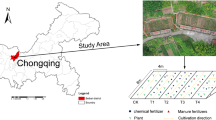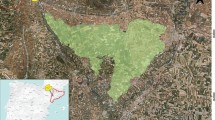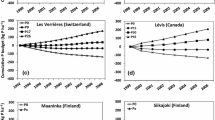Abstract
In the reclamation of scrublands of Galicia in NW Spain, fertilization is necessary to establish pastures. The area is particularly responsive to P fertilizer. In order to maximize the efficiency of use of fertilizer in planning fertilization programs, it is necessary to take into consideration the residual as well as the freshly added P.
Phosphate fertilization experiments were conducted in four sites in Galicia having a range in soil properties. The treatment design allowed estimation of residual P one year after fertilization in terms of freshly applied P equivalents.
Four non-linear models were fitted to the data from the experiments after it was determined that residual soil P one year after fertilization was proportional to the amount of P applied. The estimated proportion of P remaining one year after application appeared to be independent of the model chosen. The Mitscherlich performed best from the standpoint of average residual mean squares, total rank, residual behavior after the fit and ease of fit.
The percent of fresh fertilizer equivalent estimated one year after addition ranged from 60–90 for soils formed from granite, 30–60 for soils from slates, and 30 for soils over schist and gabbros.
Similar content being viewed by others
References
Arndt W and McIntyre GA (1963) The initial and residual effect of superphosphate and rock phosphate for sorghum on a lateritic red earth. Aust J Agric Res 14:785–795
Barrow NJ (1960) Evaluation and utilization of residual phosphorus in soils. In Khasawneh FE, Sample EC and Kamprath EJ, eds. The role of phosphorus in agriculture. Madison, Wisc.: American Society of Agronomy
Barrow NJ and Campbell NA (1972) Methods of measuring residual value of fertilizers. Aust J Exp Ag An Husb 12:502–510
Black CA and Scott CO (1956) Fertilizer evaluation: I. Fundamental principles. Soil Sci Soc Am 20:176–179
Bliss CI (1967) Statistics for biology, vol. 2. New York: McGraw-Hill
Colwell JD (1974) The derivation of fertilizer recommendations for crops in a nonuniform environment. In Fernandez H (ed) Fertilizer, crop quality and economy, 935–959. New York: Elsevier Scientific Publishing Co.
Crowther EM and Cooke GW (1951) The production and agricultural value of silicophosphate fertilizers. Part IV. Field experiments. Ministry of Supply Permanent Records of Research and Development. Monograph 11:108
Devine JR, Gunary D and Larsen S (1968) Availability of phosphate as affected by duration of fertilizer contact with soil. J Agric Sci Camb. 71:359–364
Dillon JL (1977) The analysis of response in crop and livestock production. New York: Pergamon Press
Gallant AR (1975) Testing a subset of the parameters of a nonlinear regression model. J Am Stat Assn 70, 927–932
Helyar KR and Godden DP (1977) The biology and modelling of fertilizer response. J. Aust Inst Agr Sci 41:22–30
Mattingly GEG (1971) Residual value of phosphate fertilizers on neutral and calcareous soils. In Residual value of applied nutrients. Min Agr Fish and Tech Bull 20. London: HMSO
Mattingly GEG and Penny A (1968) Evaluation of phosphate fertilizers. I. Immediate value of dicalcium phosphate, nitrophosphates, gafsa rock phosphate, basic slag and potassium metaphosphate for barley and ryegrass. J Agric Sci, Camb 70:131–138
Mattingly GEG and Widdowson FV (1956) The use of32P-labelled fertilizers to measure «superphosphate equivalents» of fertilizers in field and pot experiments. 6th Congress Sci du Sol. 461–471
Mattingly GEG and Widdowson FV (1963) Residual value of superphosphate and rock phosphate on an acid soil. I. Yield and phsophorus uptake in the field. J Agric Sci 60:399–407
Mitscherlich EA (1909) Das gesetz des minimums und das gesetz des abnehmenden bodenertrages. Landw Jahrb 38:537–552
Mombiela FA and Mateo ME (1982) Respuesta a seis dosis de P y de cal en el establecimiento de praderas permanentes en dos tipos de suelos gallegos a monte. Pastos 1:187–201
Nelder JA (1966) Inverse polynomials, a useful group of multi-factor response functions. Biometrics 22:128–141
Ross GJS (1982) Maximum likelihood program. Rothamsted Exp Stn, Harpenden, GB
Sparrow PE (1979) Nitrogen response curves for spring barley. J Agric Sci Camb 92:307–317
Warren RG (1956) N.P.K. residues from fertilizers and farmyard manure, in longterm experiments at Rothamsted. Proc Fert Soc (London) 37:3–24
Author information
Authors and Affiliations
Rights and permissions
About this article
Cite this article
Mombiela, F., Nelson, L., Fernandez, A. et al. Residual soil P values for permanent pastures on reclaimed scrubland from Galicia (NW Spain).. Fertilizer Research 9, 199–212 (1986). https://doi.org/10.1007/BF01050346
Accepted:
Issue Date:
DOI: https://doi.org/10.1007/BF01050346




